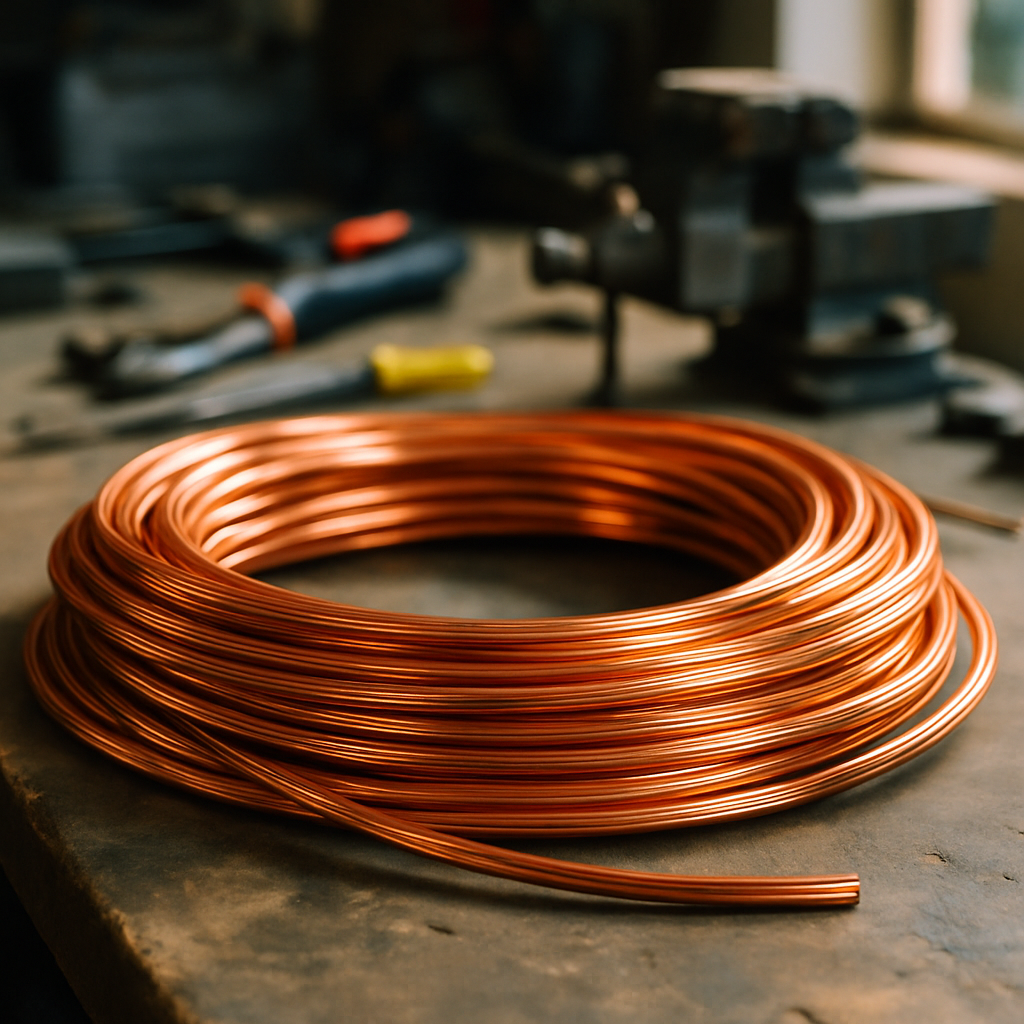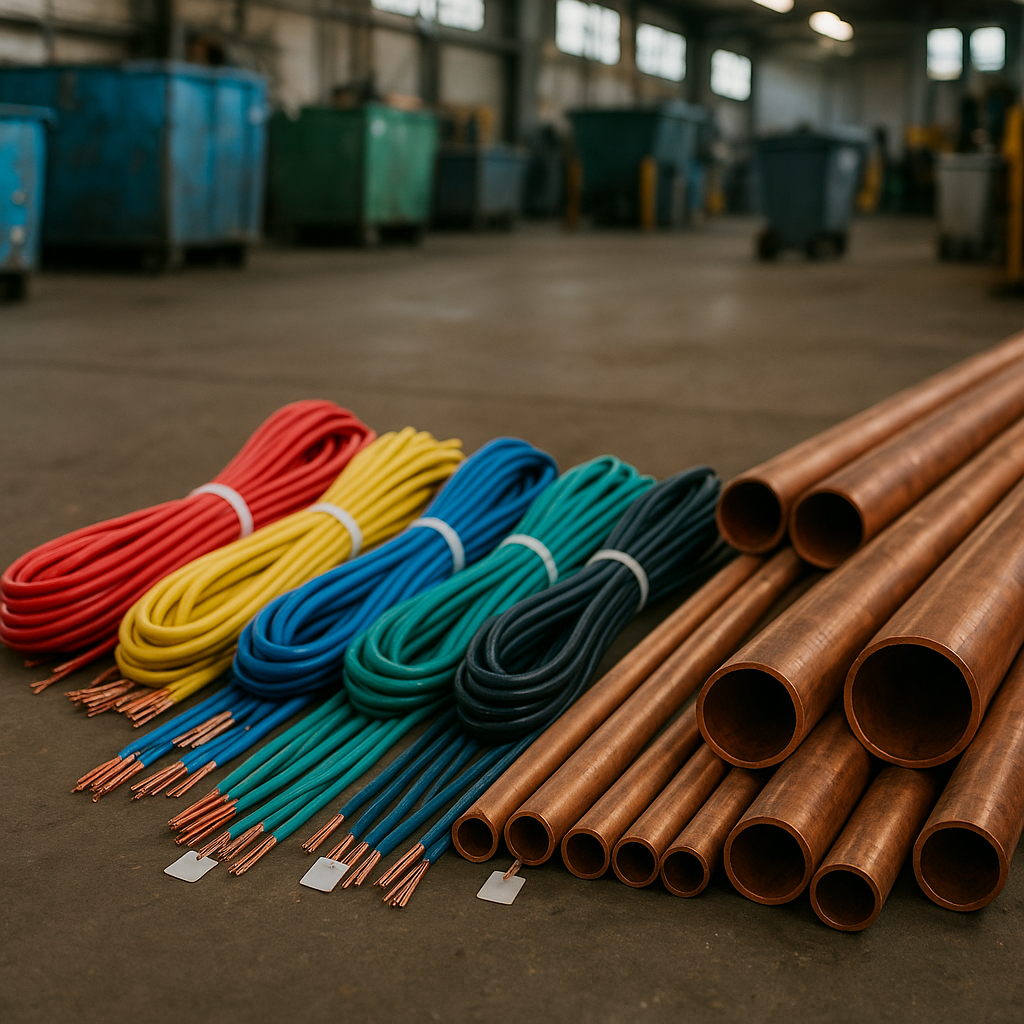5901 Botham Jean Blvd, Dallas, TX 75215
A Guide to the Main Types of Copper Scrap (And Their Value)
October 31, 2025Copper is one of the most valuable materials in the recycling industry, commanding premium prices and playing a crucial role in sustainable resource management. Understanding the different grades of copper scrap is not just beneficial—it is essential for maximizing value and ensuring proper recycling processes.
The recycling market classifies copper scrap into distinct categories based on purity, contamination levels, and processing requirements. Each grade has a different price point, with variations sometimes exceeding several dollars per pound between the highest and lowest qualities.
For recyclers, scrap yards, and metal collectors, accurately identifying these grades directly affects financial returns. Whether handling industrial quantities or smaller amounts from renovation projects, knowing what you have ensures you receive fair compensation for your materials.
What is Bare Bright Copper Scrap?

Bare Bright Copper is the most valued grade of copper scrap, recognized for its distinctive bright and shiny appearance. This premium material ranks highest in the recycling hierarchy, with scrap yards seeking it for its exceptional quality and minimal processing needs.
The specific characteristics of Bare Bright Copper include being uncoated and unalloyed copper wire or cable, with a minimum thickness of 16 gauge. Copper pipes do not qualify for this classification, regardless of condition.
Purity is crucial for Bare Bright Copper, maintaining a copper content of 99% or higher. The material must be free of paint, insulation, oxidation, or contaminants. Even slight tarnishing disqualifies it from this category. This high purity level explains its top dollar value in recycling markets.
Common sources of Bare Bright Copper include electrical wiring from construction projects and bus bars from industrial electrical systems. These sources yield the clean, uncontaminated copper that recyclers value.
The recycling value of Bare Bright Copper lies in its efficient processing. Its high purity allows recyclers to melt and reuse it with minimal refinement, requiring far less energy compared to lower grades or raw ore extraction.
Market prices for Bare Bright Copper fluctuate but consistently outperform other grades, with current rates exceeding $4.30 per pound at some facilities. This premium pricing reflects the high demand and intrinsic value in manufacturing.
Proper identification of Bare Bright Copper involves careful inspection. Look for its reddish-orange color, uniform brightness without dark spots or tarnish. A quick magnet test confirms authenticity since copper is non-magnetic.
For maximum returns, properly sorting valuable copper is essential. Keep Bare Bright Copper separate from insulated wire, pipes, or tarnished materials to maintain its premium status and value.
How Do No. 1 and No. 2 Copper Scrap Differ?

The primary difference between No. 1 and No. 2 copper scrap is their purity levels and physical characteristics. No. 1 copper contains a higher copper content of 95-99%, while No. 2 typically has 94-96% copper. This distinction significantly impacts their value and use in recycling.
No. 1 copper scrap consists of clean, unalloyed copper with minimal impurities. It may have slight oxidation but remains free from coatings, paint, solder, and other contaminants. This grade appears cleaner and brighter, making it immediately recognizable to experienced recyclers. You will often find No. 1 copper in plumbing pipes, copper sheet metal, bus bars, and high-quality copper tubing at least 1/16 of an inch thick.
No. 2 copper scrap, although still valuable, contains more impurities and visible contaminants. This grade includes unalloyed wire or pipe with coatings, paint, solder, or minor corrosion. The lower purity results in a darker appearance compared to No. 1 copper. Sources of No. 2 copper typically include used plumbing pipes with soldered joints, copper with enamel coatings, and roofing materials exposed to the elements.
The processing requirements for these grades differ substantially. No. 1 copper requires minimal processing before reuse, contributing to its higher market value. In contrast, No. 2 copper needs additional refining to remove coatings and impurities, which lowers its price point in the scrap market. Despite this value difference, both grades are crucial to the copper recycling ecosystem.
When identifying your copper scrap, examine it for visible coatings, paint, or soldered connections. Clean, uncoated copper pipes and wires likely fall into the No. 1 category, while those with visible coatings or tarnishing typically classify as No. 2. This distinction matters because scrap yards pay premium prices for higher-grade copper, making proper identification financially beneficial for recyclers.
For industrial applications, No. 1 copper is often recycled into new copper wiring, pipes, or products requiring high-grade copper. No. 2 copper is used in lower-quality alloys or products where absolute purity is less critical. Both grades support the circular economy by keeping valuable metals in production instead of landfills.
The market demand for both grades remains strong due to copper’s essential role in electrical systems, construction, and manufacturing. Proper sorting maximizes the value of your scrap and supports efficient recycling processes across the industry.
What Are Insulated Copper Wire and Copper Tubing Scraps?

Insulated copper wire and copper tubing are two of the most valuable materials in the recycling stream. These common scraps are found in many applications across homes and businesses, making them accessible sources for recycling programs focused on conserving resources.
Insulated Copper Wire Explained
Insulated copper wire comprises copper conductors covered with plastic or rubber insulation. This protective covering serves as electrical insulation and prevents short circuits. The recycling value of insulated copper wire primarily depends on two factors.
The first is the copper-to-insulation ratio. A higher copper content relative to insulation material means greater value. The second is wire gauge thickness; thicker wires contain more copper by volume and thus fetch higher prices at recycling facilities.
Insulated copper wire is typically categorized into grades based on these factors:
- #1 Insulated Copper (70%): High-quality wire with minimal insulation containing 70% or more copper by weight
- #1 Insulated Copper Romex (60%): Common residential electrical wiring with moderate insulation
- #2 Insulated Copper (50%): Wire with thicker insulation and approximately 50% copper content
- #3 Insulated Copper (30-40%): Wire with significant insulation and lower copper content
Copper Tubing and Solids
Copper tubing is another valuable recycling commodity, including clean copper pipes and tubing typically found in plumbing systems, HVAC installations, and refrigeration units. Unlike insulated wire, copper tubing is generally bare metal without coatings.
The most valuable copper tubing falls into the #1 copper category, featuring clean pipes free of fittings, solder, and other attachments. Tubing with attached fittings or coatings like paint may be classified as #2 copper, which still holds significant recycling value, albeit at a lower rate than pristine material.
Where to Find These Materials
Insulated copper wire and copper tubing scraps are commonly found during renovations, demolitions, and equipment replacements. In homes, these materials appear during electrical upgrades, appliance replacements, and plumbing renovations. Many residences contain substantial copper in wiring, water lines, and HVAC systems.
Businesses and commercial properties usually generate larger volumes during facility upgrades, equipment decommissioning, and manufacturing operations. Electrical contractors, plumbers, and HVAC technicians regularly accumulate these materials as byproducts of their work.
Preparing Copper Materials for Recycling
Proper preparation maximizes the recycling value of these materials. For insulated copper wire, consider these practices:
- Sort wire by type and gauge thickness to receive appropriate pricing
- For large volumes, mechanical wire stripping equipment can significantly increase value
- Avoid burning insulation off wire, as it releases toxic chemicals and is illegal in most areas
- Remove any non-copper attachments like plugs, connectors, or terminals
For copper tubing preparation:
- Remove fittings, valves, and solder points when possible
- Clean off any surface contaminants
- Separate tubing from other metals to prevent downgrading
- Cut longer lengths into manageable sections for transport
The recycling process for insulated wire typically involves chopping the wire into small pieces and separating the copper from insulation through mechanical processes. Copper tubing generally undergoes shredding and melting for remanufacturing into new products.
Both insulated copper wire and copper tubing are high-value recycling materials with strong environmental benefits. Recycling copper uses approximately 85% less energy than mining and processing new copper ore, making it both economically and environmentally beneficial to recover these materials from waste streams.
Conclusion: Why Knowing Your Copper Grade Matters
Understanding the main types of copper scrap is the single most important factor in maximizing your financial return. The price difference between premium Bare Bright Copper and a lower No. 2 grade can be substantial. By taking a few extra moments to properly identify and sort your materials—separating clean, shiny wire and pipes from those with solder, paint, or heavy tarnish—you ensure you receive the highest possible value for your efforts.
Don’t let your high-grade scrap get downgraded. To partner with experts who provide transparent, fair grading and offer top-market prices for all your copper scrap, contact Okon Recycling at 214-717-4083 today.
